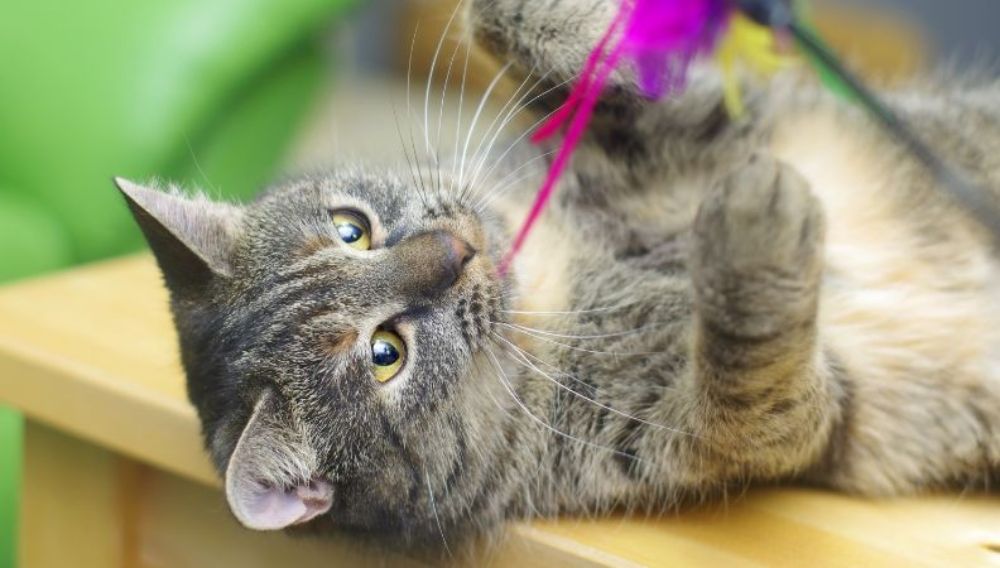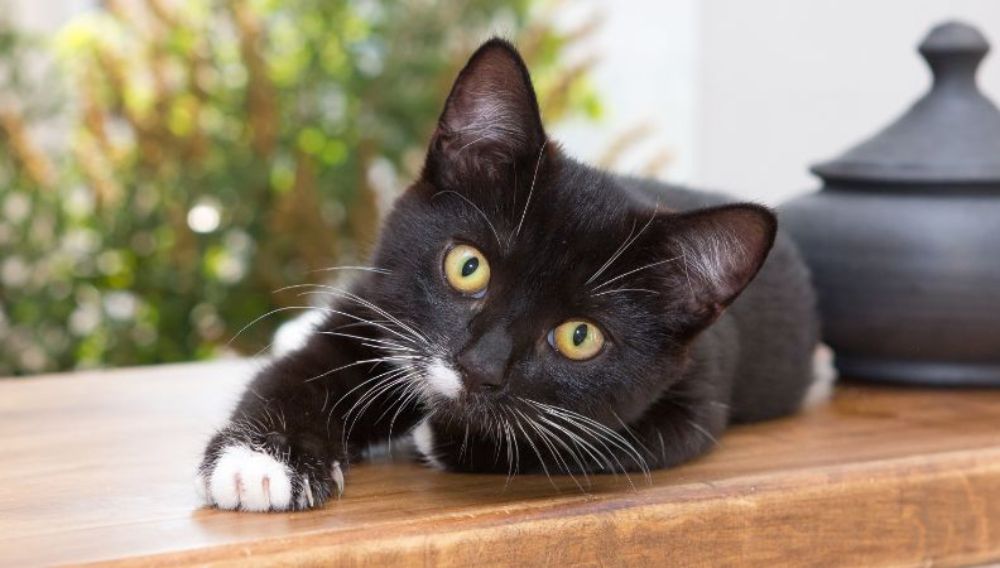
We all need exercise to keep fit, maintain good muscle and bone strength, and prevent us from getting fat! Cats are no different, but today cats either live completely indoors or partially indoors so ensuring your cat's exercise and playtime is part of their daily routine is important.
To help you understand about the importance of exercise for your cat we have joined up with Vetstream, experts in the veterinary field, to put together some information on cat exercise including how much exercise your cat may need, and how to encourage your cat to do more and stay healthy!
How to Get Your Cat to Exercise?
Kittens don’t need much encouragement to exercise as they love to play. A small, prey-sized toy is ideal - they will pounce, bat and chase the toy, having lots of fun. This behaviour mimics their natural hunting instincts. Toys can easily be found at your local pet store, but homemade toys like a scrunched up piece of foil or ping-pong ball will also make fun things to play with.
If your kitten or young cat has a companion, they may interact in social play, like chasing each other or play fighting. Older cats may interact with each other too if they have a good relationship – otherwise it may end up in a real fight.
If you have adopted an adult cat, they may not be used to playing, so introduce regular play sessions into their routine. This will strengthen your relationship and help them settle into their new home.
As your cat gets older, they may need a bit more encouragement to exercise. But, they might still enjoy a mad five minutes before they settle down for another cat nap. Cats love to climb so provide them with a cat tower, or tree with a perch and tempt them to play with fishing-rod toys, and laser pointers.
How Much Exercise Does a Cat Need?
Ideally your cat should get around 30 minutes of exercise each day. Cats prefer to have short bursts of exercise so their cat play time should be split into a couple of sessions twice a day. You may find that older cats may need less time exercising and younger cats may want more.
You’ll soon get to know how much exercise your cat needs. You may also find that some breeds are naturally more active than others like the Siamese, while other breeds such as the Persian definitely prefer a more quiet and sedate lifestyle.
Top 10 Ways to Exercise Your Cat
There are plenty of ways you can encourage your cat to get some exercise, especially if they’re a bit of a couch potato!
Here are 10 ways to get your cat to exercise:
- Prey-like toys: cats can act out their natural hunting behaviour in a fun and active way
- Fishing-rod or wand toys: for chasing and catching
- Laser pointers: endless entertainment but with no reward so cats can become frustrated. Reward them with a treat or toy after playing this game
- Cat trees, towers or perches: cats love to climb and scratch
- Companion: a feline friend to chase and play with every day is great exercise without them even realising it
- Catios: if your cat is normally kept indoors, a catio cat patio is a great way for your cat too get outdoors in a safe enclosure. They usually have different height levels for your cat to jump on, and can be put on a small patio or balcony
- Cat wheels: not all cats will take to this activity, a bit like a hamster wheel for cats!
- Cat nip: can be used to trigger play but some cats can become over-aroused
- Leash walking: some breeds can adapt to walking on a leash/harness but will take some training and time for your cat to walk on a lead and get used to wearing the harness
- Puzzle feeders: these are great for encouraging your cat to work for their food, providing mental stimulation as well as exercise. A great way of feeding greedy cats that are prone to getting fat

Ways to Exercise Your Indoor Cat
There’s no excuse for an indoor cat not to get plenty of exercise! There are lots of ways for your cat to exercise both physically and mentally to keep both body and mind healthy. Try to promote natural behaviours like chasing and pouncing, climbing and scratching, hiding and feeding opportunities that mimic feeding in the wild.
Try toys that mimic prey and let them catch them after playing for several minutes. Fishing-rod toys are brilliant for interactive play. In addition to cat toys, cats love scratching posts and cat trees, towers or perches.
Cats like somewhere high to sit, where they feel safe and survey the world. A simple cardboard box will provide a hiding opportunity. Some cats may even like to play fetch, and some might enjoy a cat exercise wheel.
Cats in the wild are used to hunting for up to 8 hours a day and having small infrequent meals. Let your cat find small meals in various locations around the house and provide puzzle feeders to encourage foraging for food.
As cats tend to be more active early in the morning and in the evening (when they would hunt in the wild), set aside these times for play.
How to Get a Fat Cat to Exercise
If your cat is obese or overweight, they may be less able to perform normal cat activities such as grooming, hunting, playing or patrolling its territory. Wild cats burn up calories by hunting for food, pet cats get everything handed to them on a plate!
If your cat has access to the outdoors, encourage them to go out more regularly and try different types of toys for them to play with. It can be difficult at first but keep persisting. Short, frequent play sessions are best to get their attention. Remember not to give them food as treats though – your time, attention and playing together should be their rewards.
Common Cat Injuries from Exercise
Cats can suffer muscle, tendon and ligament strains, sprains and tears from over-exertion. Awkward falls can result in joint problems and even bone breaks. Luckily, these are uncommon but if your cat is stiff, reluctant to bear weight on a limb, or can’t move a joint, contact your vet for advice.
Other injuries could include a torn or broken nail. Jumping from a height or catching a nail can cause a tear or break. Nails bleed a lot so you might notice some bleeding, or they might lick their paw a lot, they may even be limping. If you notice any of these signs it might be worth calling your vet.
Health Benefits for You and Your Cat
Spending time playing with your cat has benefits all round. Exercise is not only important for physical health, but good for your cat’s mental well-being too. A fit happy cat is less likely to feel anxious and stressed. In addition, it will strengthen the bond between you and your feline friend so make time for those regular play sessions - it will be fun for both of you!
Everypaw Cat Insurance
Everypaw's Cat Insurance comes with 24/7 unlimited access to vets and vet nurses that can help with your pet's health, care, nutrition and behaviour. So you can rest assured your kitty will be well looked after.
Content reviewed and updated by Vetstream - www.vetstream.com/treat/felis
Vetlexicon is the world’s largest peer-reviewed online clinical reference source. All our content is written and peer-reviewed by over 1,000 of the world’s leading veterinarians, ensuring relevance, accuracy and quality.
- Alexandra Taylor, Vetstream Ltd (online) Exercise – how to get your cat to do more Client Information. In: Vetlexicon Felis. Vetstream Ltd, UK. Website: https://www.vetlexicon.com/treat/felis/client-information/exercise-how-to-get-your-cat-to-do-more
- Vetstream Ltd, Allison German (online) Obesity Client Information. In: Vetlexicon Felis. Vetstream Ltd, UK. Website: https://www.vetlexicon.com/treat/felis/client-information/obesity
- Jenna Kiddie, Ilona Rodan (online) Indoor cats Client Information. In: Vetlexicon Felis. Vetstream Ltd, UK. Website: https://www.vetlexicon.com/treat/felis/client-information/indoor-cats